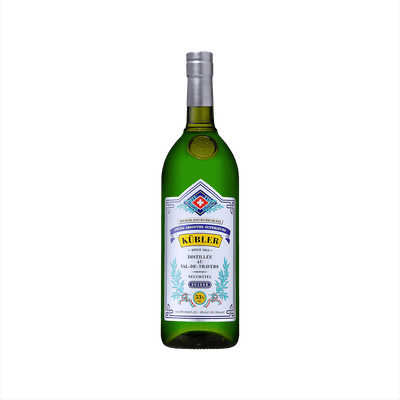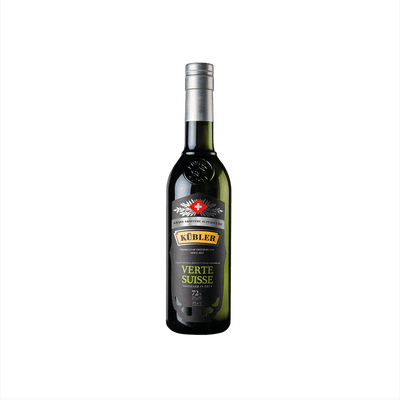Absinthe
What is Absinthe?
Absinthe is a high-proof spirit that's defined by its distinctive botanical blend featuring grande wormwood (Artemisia absinthium), green anise, and sweet fennel as its holy trinity of flavors. This anise-forward liqueur typically clocks in between 45-74% ABV and turns milky when mixed with cold water due to the oils from its botanical ingredients creating what's called the "louche" effect. What sets absinthe apart from other anise spirits like pastis or ouzo is specifically that wormwood component, which gives it its characteristic bitter herbal complexity and its legendary reputation as the "Green Fairy."
Learn More About Absinthe
What are the different types of Absinthe?
Absinthe splits into three main categories: traditional verte (green), blanche (clear), and rouge (red), with each offering distinct character profiles. Verte gets its emerald color from chlorophyll during the final maceration with herbs like petite wormwood and hyssop, delivering the most complex herbal notes. Blanche skips this coloring step, resulting in a crystal-clear spirit with cleaner, more focused anise and fennel flavors, while rouge uses additional botanicals or natural coloring to achieve its amber-red hue and often features a spicier, more robust taste profile.
How is Absinthe made?
Absinthe starts with a neutral grain spirit that gets infused with a blend of botanicals - most importantly wormwood (Artemisia absinthium), along with green anise and sweet fennel as the holy trinity of flavors. The herbs are either macerated directly in the alcohol or distilled together, with premium producers often using a combination of both methods to extract maximum flavor complexity. After distillation, many traditional absinthes get their signature green color from a second maceration with chlorophyll-rich herbs like petite wormwood, hyssop, and melissa, though some producers skip this step entirely for a clear "blanche" style.
What does Absinthe taste like? What does Absinthe bring to a cocktail?
Absinthe delivers an intense herbal punch dominated by anise and fennel, creating that distinctive black licorice flavor that either captivates or repels drinkers. The green fairy also contributes bitter wormwood notes and a complex botanical backdrop of herbs like hyssop, angelica, and melissa that add layers of earthiness and floral touches. In cocktails, absinthe works magic as a rinse or in small doses, contributing an aromatic complexity and slight bitter edge that transforms drinks like the Sazerac or Corpse Reviver #2 into something wonderfully mysterious and herbaceous.
How do you drink Absinthe? In what kind of cocktails does Absinthe shine?
The classic absinthe ritual involves slowly dripping ice-cold water over a sugar cube placed on a slotted spoon, diluting the spirit to a milky, opalescent louche that releases its botanical complexity. Beyond this traditional preparation, absinthe works magic in cocktails like the Sazerac, where just a rinse coats the glass with herbal aromatics, or the Corpse Reviver #2, where a few dashes add mysterious depth without overwhelming the drink. Its intense anise and wormwood character means a little goes a long way—think of it as the culinary equivalent of adding fresh herbs to a dish, where the right amount transforms everything.
What are fun ways to drink Absinthe?
Absinthe works wonderfully in jello shots – just reduce the water slightly since absinthe will louche when mixed, creating a cloudy, mystical appearance that's perfect for Halloween parties or gothic-themed gatherings. You can absolutely make absinthe popsicles by mixing it with simple syrup and a touch of lemon juice, though the alcohol content will keep them from freezing completely solid, giving them a delightfully slushy texture. For desserts, try incorporating a small amount into chocolate truffles, panna cotta, or even ice cream – the anise and herbal notes pair surprisingly well with dark chocolate and vanilla, adding an sophisticated botanical complexity that makes guests wonder what that intriguing flavor could be.
How has Absinthe been depicted in culture?
Absinthe has long captured the imagination as the drink of bohemian artists and writers, famously associated with figures like Oscar Wilde, Henri de Toulouse-Lautrec, and Vincent van Gogh who believed it sparked creativity while slowly driving them mad. Popular culture often portrays absinthe as a mystical, hallucinogenic potion complete with elaborate rituals involving sugar cubes and ornate spoons, perpetuating myths about its supposed psychoactive properties. From the decadent salons of Belle Époque Paris to modern films and literature, absinthe remains a symbol of artistic rebellion and dangerous allure, though much of its legendary reputation stems more from romantic fiction than historical fact.
Nutritional Information
Typical Calorie Range per Ounce: 80-100 calories
Typical Carbohydrate Range per Ounce: 0-1 grams
Typical Sugar Range per Ounce: 0 grams
Typically Gluten Free: Yes
Most absinthe is made from distilled botanicals including wormwood, anise, and fennel, which naturally contain no gluten. The distillation process also removes gluten proteins that might be present in any grain-based alcohol used in production. But here's the thing - individual brands may vary in their production methods or add ingredients after distillation. Always check the specific product label and manufacturer information to confirm gluten-free status, especially if you have celiac disease or severe gluten sensitivity.
Scrolled this far? Your reward? Absinthe Trivia!
- The "Green Fairy" was actually clear until bartenders started adding food coloring. Original absinthe from the 1800s was naturally colorless or slightly yellow from aging in barrels. The iconic emerald green came from creative bartenders who figured out that a splash of artificial coloring made their drinks more visually striking. The naturally green versions you see today get their color from chlorophyll extracted during a secondary maceration with herbs like hyssop and melissa.
- Absinthe was banned not because it was hallucinogenic, but because French wine producers lobbied against it. When the phylloxera epidemic destroyed French vineyards in the 1860s-1880s, absinthe became wildly popular as wine became scarce and expensive. Once the wine industry recovered, they launched a massive propaganda campaign claiming absinthe caused madness and violence. The "psychoactive" effects people reported were simply from drinking 120+ proof alcohol on empty stomachs.
- The traditional absinthe ritual exists because 19th-century absinthe was purposely made bitter. Distillers intentionally left their absinthe harsh and medicinal-tasting because they believed bitter herbs were healthier. The elaborate water-dripping ceremony with sugar cubes wasn't just theater – it was absolutely necessary to make the stuff drinkable. Modern absinthe is typically much smoother and can be enjoyed neat.
- Ernest Hemingway invented his own absinthe cocktail using champagne and called it "Death in the Afternoon." His recipe was simple but deadly: pour one jigger of absinthe into a champagne flute, add iced champagne until it attains the proper opalescent milkiness, then drink three to five of them slowly. He contributed this recipe to a 1935 celebrity cookbook with the warning that the drink should be consumed slowly.
- Thujone, the compound that supposedly made absinthe dangerous, is found in much higher concentrations in sage than in any bottle of absinthe. The wormwood used in absinthe contains trace amounts of thujone, but a typical serving contains less than what you'd get from seasoning your Thanksgiving turkey with sage. The European Union allows up to 35mg of thujone per liter in absinthe, while burning sage in your kitchen exposes you to significantly more.
Higher-proof spirits can be intense. Sip slow, taste thoughtfully, and enjoy responsibly.
Gift message (optional)














